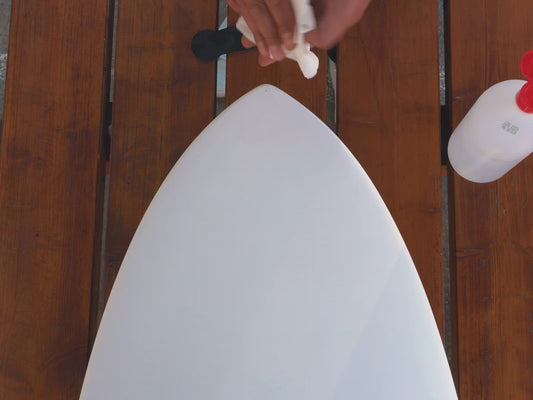Surf Travel: The Pros and Cons of Exploring the Waves Abroad
Carles CarreraShare
Surfing is more than just a sport, it's a way of life. For surfers, there's nothing quite like the feeling of catching a wave and riding it to shore. But what happens when the waves in your local spot are flat, or when you're tired of surfing the same break over and over again? That's where surf travel comes in.
Discovering new places, cultures, and waves is one of the best things about surfing. However, traveling with your surfboards can be stressful, difficult, and expensive, not to mention the risk of damage to your board. In this blog post, we'll explore the pros and cons of surf travel and a couple of solutions to make it more enjoyable.

The Pros of Surf Travel
Surfing is a sport that's all about adventure and exploration. There's nothing quite like the feeling of discovering a new break, riding a wave you've never experienced before, and immersing yourself in a new culture.
Here are some of the pros of surf travel:
- Discover New Places and Cultures: Surfing is a global sport, and there are incredible breaks all over the world. By traveling to surf, you can experience new countries, meet new people, and learn about different cultures. Surfing is a great way to connect with people from different backgrounds, and it's an opportunity to broaden your horizons.
- Escape Cold Winters and Lack of Waves: If you live in a place that's cold in the winter or lacks consistent waves (here we are in the “lake” Mediterranean), surf travel can be a great way to get your surfing fix. By chasing the waves, you can escape the winter doldrums and enjoy warmer climates and consistent surf.
- Improve Your Skills: By exploring new breaks and experiencing different conditions, you can improve your surfing skills. Whether it's learning to read different types of waves, honing your turns, or practicing your barrel riding, surf travel is a great way to become a better surfer.
The Cons of Surf Travel
While surf travel can be incredibly rewarding, it's not without its challenges. Traveling with your surfboards can be stressful, difficult, and expensive, and there's always a risk that your board will be damaged in transit.
Here are some of the cons of surf travel:
- Transportation Hassles: Getting your surfboards to your destination can be a challenge. Airline fees for oversized baggage can be expensive, and you run the risk of your boards being damaged or lost in transit. Even if you manage to get your boards to your destination in one piece, transporting them to and from the beach can be an added hassle.
- Language Barriers: Traveling to a new country can be exciting, but it can also be challenging if you don't speak the language. Trying to rent a car or find your way to the beach can be frustrating if you can't communicate effectively. But it’s always great to push yourself and don’t be afraid of the language barrier.
- Safety Risks: Surfboards are valuable and fragile, and there's always a risk that they'll be damaged or stolen while you're traveling. This can be stressful and can put a damper on your trip. Mitigate these risks by investing in secure and protective packaging for your surfboard.
Split Surfboards: The Solution to Transportation Woes
One solution to the transportation challenges of surf travel is the split surfboard. Split surfboards are designed to come apart into two pieces, making them much easier to transport. With a split board, you can fit your board into a “regular” suitcase or backpack, eliminating the need for oversized baggage fees and reducing the risk of damage in transit.
Companies like Sunova have been leading the way in split surfboard design, creating high-performance boards that can be easily taken apart and reassembled.
Enter the Sunova Split Longboard.
HexaTraction: The Alternative to Surf Wax for Travelers
Another challenge of surf travel is dealing with surf wax. Wax can melt in hot temperatures, become brittle in cold temperatures, and is messy and time-consuming to apply and remove. Plus, different water temperatures require different types of wax, making it difficult for travelers who may be surfing in different climates.
That's where HexaTraction by RSPro comes in as a great alternative to traditional surf wax. HexaTraction is a clear (or coloured) traction system that uses hexagonal and super thin traction pads to provide grip and traction on your surfboard. It's easy to install, lightweight, and can be removed without damaging your board.
Unlike wax, it doesn't melt or become slippery in warm water, and it won't stick to your clothes or car seats. Using HexaTraction not only saves you the hassle of carrying and applying wax on your surf trips, but it also helps to reduce the amount of plastic waste that ends up in the ocean.
Conclusion
In conclusion, surf travel is one of the most exciting and rewarding experiences that any surfer can have. It provides the opportunity to explore new places, meet new people, and enjoy some of the best waves that the world has to offer. However, traveling with your surfboard can be stressful, expensive, and risky. By using split surfboards like Sunova's and alternative traction systems like RSPro's HexaTraction, surfers can enjoy the benefits of surf travel without the added hassle and worry. So pack your bags, grab your board, and get ready to explore the world one wave at a time!









